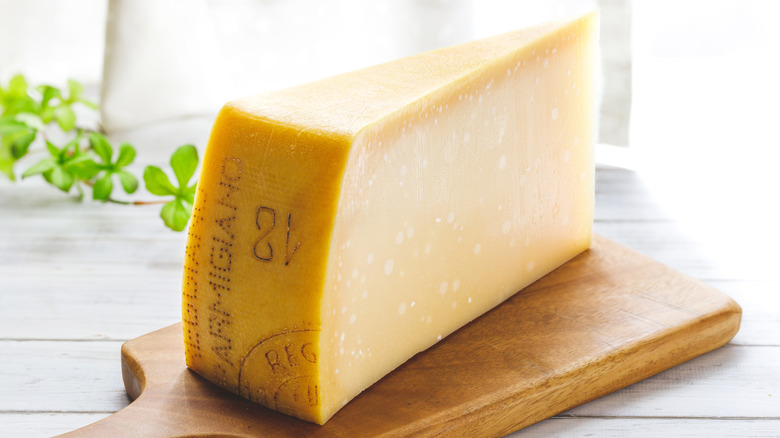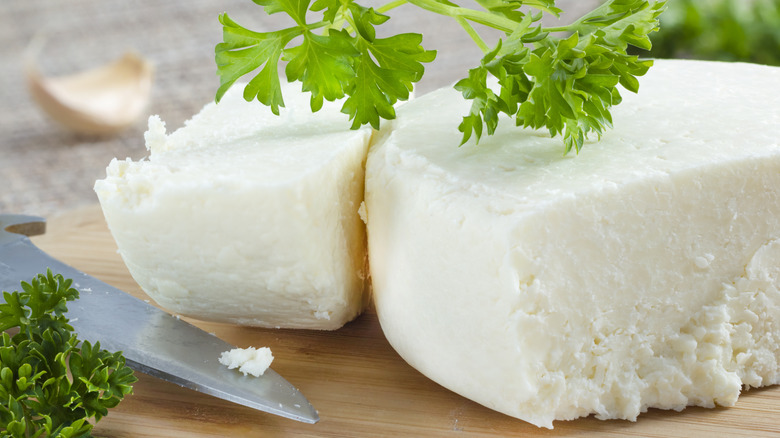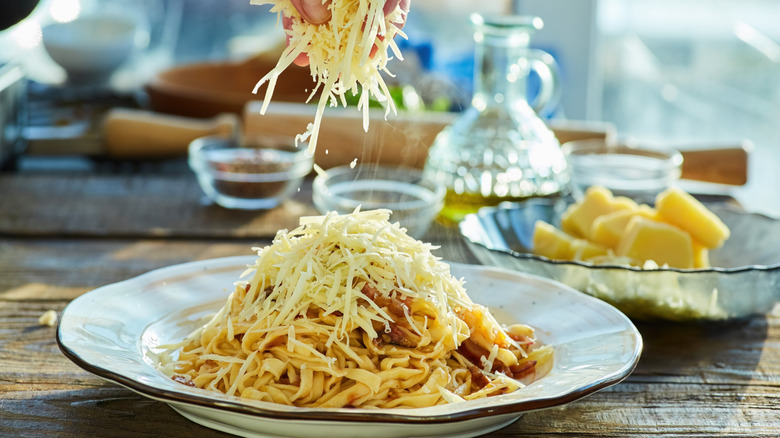Cotija Vs Parmesan: What's The Difference?
Cotija is sometimes known as the "Parmesan of Mexico." And Parmesan has been called the "King of Cheeses." Often added as a finishing touch to some of the best loved dishes in their countries of origin — Mexico and Italy, respectively — the two cheeses are hardly afterthoughts. Both earned their lofty monikers by turning even the simplest street food or ordinary pastas into elevated gourmet dishes.
Salty and strong in flavor, and crumbly in texture, they can easily be mistaken for one another. But there are subtle differences between the two that you should be aware of before you start grating cotija over your pasta, or dusting an ear of corn with Parmesan. A little bit goes a long way when it comes to cotija, which can have a slightly funky flavor, while it's often the case that more is more with the milder Parmesan. Both change with age, so you'll need to take that into account when deciding when and how to use each cheese. Still, adding these cheeses to your Mexican and Italian dishes can be a recipe for success.
The confusion over Parmesan cheese
To understand the difference between Parmesan cheese and cotija, it's helpful to first know the differences among parmesan (with a lowercase P), Parmesan (with a capital P) and Parmigiano Reggiano. Italian Parmesan and Parmigiano Reggiano are both Italian cheeses made from skimmed, unpasteurized cow's milk, aged for at least one year and up to four or more. In the European Union (EU) and Italy, Parmesan and Parmigiano Reggiano are protected designations for cheese produced under certain conditions, using specific standards.
In the United States, parmesan generally refers to hard cheeses made in the style of Parmesan, but with fewer restrictions. Parmigiano Reggiano must be made using rennet and from cows fed mostly locally-grown forage, grass, and hay. The Food and Drug Administration (FDA) requires parmesan to be made with certain levels of moisture and fat content and with specific production methods, but there are no regulations on things like the type of rennet used or how the cows are fed. While it is usually aged for at least 12 months, it can also contain other ingredients like preservatives which are not allowed in Parmigiano Reggiano. Most of the pre-grated cheese available in the United States is the imitation style parmesan but, to add to the confusion, is often called Parmesan.
The looser requirements for parmesan in the U.S. are why chefs like Ina Garten will only buy Parmigiano Reggiano. For a true comparison to cotija, you must look at Italian-made Parmesan or Parmigiano Reggiano. Parmigiano Reggiano should also not be confused with pecorino, a sheep's milk cheese that's also popular in Italy.
Cotija: the Parmesan of Mexico
You could say that cotija, one of the essential ingredients of Mexican food, has a dual personality. When aged only for a short period of time, the white cow's milk cheese is moist and crumbly and similar to feta cheese. When aged longer, it becomes sharper and firmer— more like Parmesan — and better suited to sprinkling rather than crumbling. Cotija is named for the city of the same name, located in Michoacán. Spanish settlers brought European cheese-making techniques to Mexico during the colonial period, beginning in the 16th century. Although Parmigiano Reggiano has been made in the Emilia-Romano region of Northern Italy since the Middle Ages, it did not become an officially designated product of the region until 1934.
Unlike Parmesan, cotija is not made according to closely-held standards like many of the cheeses of Europe. It is generally aged for three months to a year. Over time, it becomes increasingly salty and can also have a strong, pungent flavor. Parmesan, on the other hand, has a salty, tangy, and nutty flavor with some sweet notes. It develops a crumbly, increasingly brittle texture as it ages. Cotija also differs from Parmesan in its high rennet content, which allows the cheese to soften but not melt.
A sprinkle of cheese that's long on flavor
Its strong flavor and inability to melt helps explain why cotija is most commonly sprinkled onto dishes like enchiladas, nachos, tacos, and enchiladas. It is rarely baked into dishes and you'll almost never see it placed on a Mexican table to be eaten on its own. In parts of the U.S., you'll likely see cotija topping elote, the popular Mexican street food: The cheese is sprinkled liberally onto corn on the cob that has been slathered with mayonnaise or a crema, that is then hit with a dash of lime juice and chili powder.
Of course, Parmesan is also liberally sprinkled onto a number of Italian dishes. More likely than not, you've probably had a server patiently grating the cheese onto your pasta while you signal for more and more cheese. But Parmesan is also used in a number of other ways: It can be shaved onto a salad, it serves as a welcome addition to cheese plates, and it can be incorporated into baked pastas like ziti and lasagna. Then there's the bit of tableside theater called pasta alla ruota in which hot pasta is placed inside a hollowed-out wheel of Parmesan, and mixed by the server until every bit of the pasta is covered with delicious melted cheese.
Luckily, you don't have to travel to northern Italy or western Mexico to enjoy these wonderful cheeses. Whether you're just giving your dish a light dusting of cheese or turning a cheese wheel into a vessel, both Parmesan and cotija will likely make you say, "More cheese, please."



